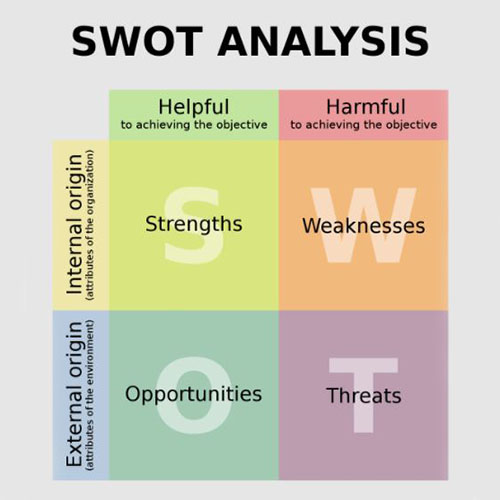Planning Process: 9 Steps in Process of Planning in Management
For good planning, it is essential to complete some procedures. For a systematic approach to planning, it is essential to complete some procedures or steps in the planning process. Determining objectives and the courses of action needed to obtain these objectives are referred to as the planning process. The following are the common process of planning:
Planning Process / Steps in Process of Planning in Management
- Analyze Opportunities
- Setting Goals
- Determination of Premises
- Determination of Alternatives
- Evaluation of Alternatives
- Selecting the Best Course of Action
- Formulation of Derivative Plans
- Implementation of the Plan
- Reviewing the Planning Process
1. Analyze Opportunities
This is the pre-step of planning. It is essential to make a successful plan. The management has to analyze the strengths, weaknesses, opportunities, and threats (SWOT) from the changing environment of the business.

Strengths and weaknesses are the outcomes of the internal environment like the availability of materials, machines, manpower, organizational structure, and technology adopted, etc. In a similar manner, opportunities and threats are the outcomes of the external environment and affected b many factors like political, economic, socio-cultural, and technology. It is essential to make a detailed study of the above factors and should consider them while setting goals.
2• Setting Goals
This is the first and actual starting point of planning. The objectives must be specific, clear, and practical. Planning should be time-bound and expressed in numerical terms. They should not be idealistic or over-ambitious. A minor mistake in setting objectives might affect the implementation of a plan. Therefore, the management has to define the objective clearly by considering organizational resources and opportunities.
After clarification of the broad objectives, it should be broken down into specific objectives of different departments, branches, and sections.
3. Determination of Premises
Premises are assumptions of the future on the basis of which the plan is formulated. The future environment is estimated on the basis of forecasting. Premises may be tangible and intangible or internal and external. Tangible premises involve capital investment, units of production, units sold, cost per unit, time available, etc. Similarly, intangible premises involve employees’ morale, goodwill, motivation managerial attitude, etc.
Internal premises involve money, materials, machines, and management. Whereas external premises involve competitors, strategies, government policy, technological change, and social and cultural beliefs.
4. Determination of Alternatives
Management needs to identify alternative courses of action for the achievement of organizational objectives. For this, it is essential to identify all the possible alternatives. The information about the alternatives may be obtained from primary and secondary sources. The management must develop alternatives through the support of experienced and intellectual experts in management. The determination of an alternative course of action is the basis of plan formulation.
5. Evaluation of Alternatives
This is a logical step to evaluate each and every alternative from the cost and benefits point of view. Each alternative is studied and evaluated in terms of some common factors such as risk, responsibility, planning premises, resources, technology, etc. Therefore, management must apply a broad-based analytical approach for the evaluation of available alternatives.
On the basis of requirements, management may apply many techniques of analysis from different disciplines such as mathematics, sociology, psychology, economics, etc. The evaluation technique must be scientific and practical so that the best course of action can be selected.
6. Selecting the Best Course of Action
Management selects the best course of action after evaluating all the alternatives. For this purpose, management has to consider past experience, present situation, and future contingencies of such a decision. Therefore, it is essential to consider the various premises and environments of an organization and their impact on the future course of action. Besides, it needs to forecast the comparative cost and benefit factors.
7. Formulation of Derivative Plans
After selecting the course of action, it is essential to formulate action plans for each department of the organization. These action plans involve the formulation of policies, rules, schedules, and budgets to achieve defined objectives. It is difficult to implement a basic plan without the formulation of derivative plans.
8. Implementation of the Plan
After the selection of a course of action and preparation of derivative plans, if not implemented, the plan remains on paper only. This step brings all the procedures of the plan into action. For the implementation of a plan, the management needs to take some steps such as communicating with subordinates who initiate plans into action, provide necessary instruction and guidance, make arrangements of all resources like materials, machines, money, equipment, etc. and make timely supervision and control of subordinates.
9. Reviewing the Planning Process
Planning is a continuous function and lasts until the organization is in existence. For this, it is necessary to know about the actual performance. The manager can take corrective action in proper time only after evaluating the actual performance. The right decision at the right time is necessary to achieve objectives according to the plan. It is also essential to adapt to the changing environment of the business.
Read More in Process of Panning in Management
